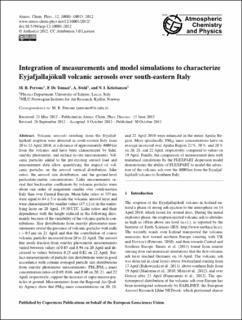| dc.description.abstract | Volcanic aerosols resulting from the Eyjafjallajökull eruption were detected in south-eastern Italy from 20 to 22 April 2010, at a distance of approximately 4000 km from the volcano, and have been characterized by lidar, sun/sky photometer, and surface in-situ measurements. Volcanic particles added to the pre-existing aerosol load and measurement data allow quantifying the impact of volcanic particles on the aerosol vertical distribution, lidar ratios, the aerosol size distribution, and the ground-level particulate-matter concentrations. Lidar measurements reveal that backscatter coefficients by volcanic particles were about one order of magnitude smaller over south-eastern Italy than over Central Europe. Mean lidar ratios at 355 nm were equal to 64 ± 5 sr inside the volcanic aerosol layer and were characterized by smaller values (47 ± 2 sr) in the underlying layer on 20 April, 19:30 UTC. Lidar ratios and their dependence with the height reduced in the following days, mainly because of the variability of the volcanic particle contributions. Size distributions from sun/sky photometer measurements reveal the presence of volcanic particles with radii r > 0.5 μm on 21 April and that the contribution of coarse volcanic particles increased from 20 to 22 April. The aerosol fine mode fraction from sun/sky photometer measurements varied between values of 0.85 and 0.94 on 20 April and decreased to values between 0.25 and 0.82 on 22 April. Surface measurements of particle size distributions were in good accordance with column averaged particle size distributions from sun/sky photometer measurements. PM1/PM2.5 mass concentration ratios of 0.69, 0.66, and 0.60 on 20, 21, and 22 April, respectively, support the increase of super-micron particles at ground. Measurements from the Regional Air Quality Agency show that PM10 mass concentrations on 20, 21, and 22 April 2010 were enhanced in the entire Apulia Region. More specifically, PM10 mass concentrations have on average increased over Apulia Region 22%, 50%, and 28% on 20, 21, and 22 April, respectively, compared to values on 19 April. Finally, the comparison of measurement data with numerical simulations by the FLEXPART dispersion model demonstrates the ability of FLEXPART to model the advection of the volcanic ash over the 4000 km from the Eyjafjallajökull volcano to Southern Italy. | en_US |

